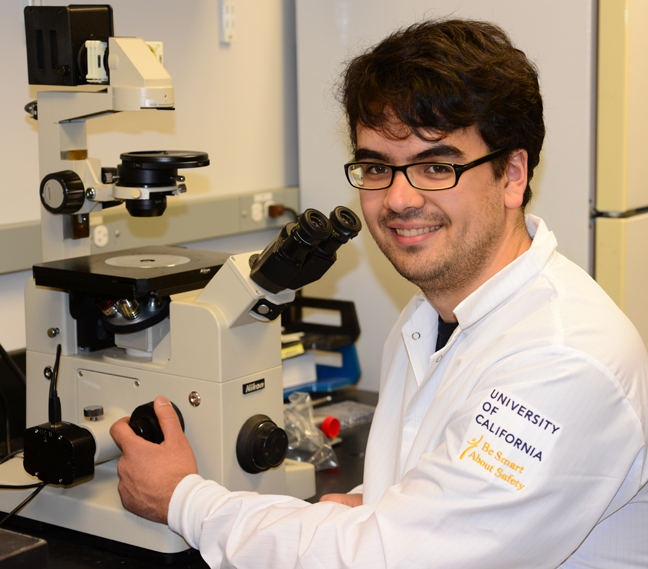- Author: Kathy Keatley Garvey
DAVIS--Graduate student researcher Sean Kodani of the Bruce Hammock lab, University of California, Davis, has received a fellowship to study omega 3 fatty acids.
The fellowship is from the Center for Content Rich Evaluation of Therapeutic Efficacy (cCRETE), headed by Katherine Ferrara, a distinguished professor and director of the Department of Biomedical Engineering and a newly selected member of the National Academy of Engineering.
The center, cCRETE (pronounced "secrete") is part of the Research Investments in Science and Engineering (RISE) Program.
Kodani's projects will involve continuing the work of Guodong Zhang, who recently received a faculty position at the University of Massachusetts, Amherst. While at Davis, Zhang found that metabolites of omega 3 fatty acids reduced angiogenesis, tumor growth and tumor metastasis. "I will be focusing on the specific pathways involved in this phenomena while also investigating the biological activity of other omega 3 metabolites," Kodani said.
"When I first rotated in Dr. Hammock's laboratory I mostly synthesized inhibitors for the enzyme soluble epoxide hydrolase, which is the primary target investigated in our laboratory," Kodani said. "However, my background is stronger in biology and biochemistry than synthetic chemistry, so when I joined the laboratory this was a project where I could incorporate all of those skills."
Kodani, from Orangevale, received his bachelor's degree in molecular toxicology and environmental sciences from UC Berkeley in 2012.
In addition to Ferrara, the leadership of cCRETE includes
- Steven C. Currall, dean and professor of Management Graduate School of Management
- Ralph deVere White, director of the UC Davis Comprehensive Cancer Center and distinguished professor of Urology
- Fredric Gorin, professor and chair of the Department Neurology
- Bruce Hammock, distinguished professor, Department of Entomology and Nematology with a jointappointment in the UC Davis Comprehensive Cancer Center
- Alexander Revzin, associate professor. Department of Biomedical Engineering, and
- Clifford Tepper, associate research biochemist, Department of Biochemistry and Molecular Medicine
The center focuses on assays of cell-secreted factors in vitro and in vivo, including exosomes, peroxide, and matrix metalloproteinases (MMPs). Cell secreted factors are of interest in 1) gauging the response to therapy with new drugs and 2) the development of an understanding of cell-to-cell communication. The “rich” content to be assessed to understand the impact of cell secretions goes beyond the quantification of traditional markers such as proliferation and apoptosis to evaluate markers of invasive potential, inflammation, “stem-ness,” autophagy and metabolic pathways.
"With respect to the response to therapy, the cost of bringing a new drug to market is now estimated to exceed $1 billion, with the timeline for developing a drug and getting it to market approaching 15 years," according to the website. "During the next 4 years, 9 of the top 10 and 18 of the top 20 best-selling drugs in the world will go off patent. A major challenge for the pharmaceutical industry is their lack of tools to identify promising candidates and to separate the winners from the losers early in the development process. Such tools have the potential to substantially reduce the cost to market for new drugs. To address the critical need for screening tools, a team of cancer biologists, social scientists, bioinformatics experts and bioengineers has formed a single disciplinary group to develop and validate biomarker assays for the effect of new therapeutics.
"In addition, members of the group (Hammock, Gorin, Ferrara) have developed novel therapeutics that effectively inhibit key pathways in cancer and atherosclerosis; the success of these new therapeutics will require biomarkers, which are one focus of our team. Therefore, one important problem to be solved is the creation of high throughput and content rich assays to summarize the impact of therapeutics on cellular functionality. We are developing in vitro cell microsystems where micropatterned co-cultures of cancer and non-cancer cells are juxtaposed with arrays of sensing elements for monitoring downstream readouts of cell-drug interactions. Further, we are developing and applying in vivo imaging approaches to assess specific targets and efficacy."
Hammock holds a joint appointment in the UC Davis Department of Entomology and Nematology and the UC Davis Comprehensive Cancer Center. He directs the campuswide Superfund Research Program, National Institutes of Health Biotechnology Training Program, and the National Institute of Environmental Health Sciences (NIEHS) Combined Analytical Laboratory.



